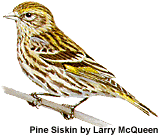Pine Siskins are
approximately 5 inches (13 centimeters) in length. A small streaky finch with a pale,
thin, pointed bill, Pine Siskins have dark wings and a tail that has a variable amount of
yellow.
The Pine Siskin is a highly social bird and
can often be found at feeders in large flocks or mixed with winter flocks of American
Goldfinches. The distinctive single- or double-note flight call of the Pine Siskin is
often heard throughout North America in the fall.
Description: The head, throat, and nape of Pine Siskins are buffy and finely
streaked with dark brown. They also have an indistinct dark brown eye stripe. From the
mantle to the rump, Pine Siskins are buffy and broadly streaked with dark brown. The
underparts are whitish and finely streaked with dark brown. The wings are primarily
blackish in color, with the median coverts having buffy edges; the base of the outer
primaries is broadly marked with yellow (on males) and buff (on females). The black tail
is notched, and the outer tail feathers have yellow bases.
A single race of Pine Siskin, Carduelis
pinus pinus,breeds from southern Alaska through Canada to Newfoundland, and south to
northern New England. Year-round, their range extends from Alaska through the Rocky
Mountains to northern Arizona.
Pine Siskins are irregularly common to
abundant in their breeding areas—in other words, one year they might be found in
abundance at a particular location, whereas the next year they are totally absent. They
are also an irregular migrant, occasionally staging massive irruptions into the middle
portions of North America, which can extend as far south as central Florida. These
irruptions may be related to fluctuations in their food supply, which consists of seeds
and buds from conifers, birches, and alders.
